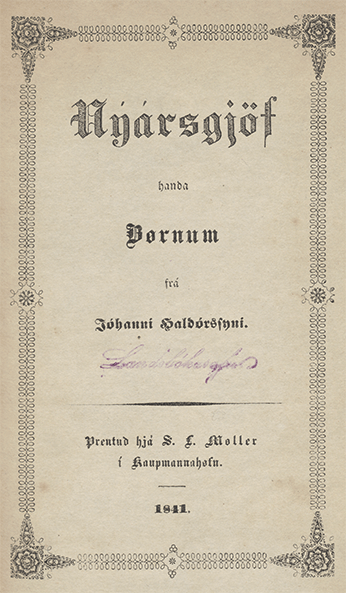Engraving in the book Nýársgjöf handa börnum (New Year's gift for children) 1841

The author, Jóhann Halldórsson (1809-1844) is one of the first Icelandic children's book authors, but no doubt some of the stories in his books are translated, though not specifically mentioned. The first Icelandic translation of a story from the adventures of the Grimm brothers, the story Maríubarnið (Mary's Child), appears in this book that was printed in Copenhagen 1841.
There are not many examples of engravings in Icelandic printed material from the 18th and 19th centuries. On the last page of this book there is a printed image made with a copper plate. The picture is a scripture writing instruction for children where two different writing methods can be seen.
Cursive Script is a magnificent script that originated in England in the late 17th century. It is based on a circular thick and thin line. By the end of the 19th century, fonts were made in the Cursive Script style, including the Snell Roundhand and Kuenstler Script fonts.
Quickie, on the other hand, is a streamlined script that evolves from the need to quickly write down speech as spoken.
This can be further explored in the exhibition A Picture is Worth a Thousand Words – On print plate making in Iceland which has been opened in the museum an don the website baekur.is


Previous highlights of the month
19. júní, annual publication of the Icelandic Women's Rights Association 1975
Previous highlights
See moreThe Finnish epic poem Kalevala bound by Unnur Stefánsdóttir
Previous highlights
See more"My sweetheart!" - The largest collection of love letters in the Women's History Archives
Previous highlights
See moreChat_
Please introduce yourself by adding name and email.
The chat is open 9:00 - 16:00 on weekdays.